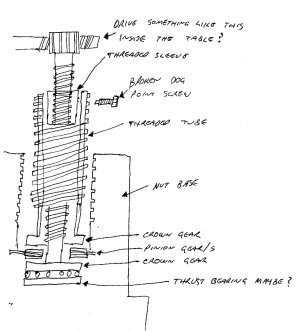- Joined
- Apr 23, 2011
- Messages
- 2,477
Ron,
That collar is only pinned to the outer tube isnt it? Not right through the sleeve and to the inner threaded section?
From what I am seeing and surmising, cranking the handle to move the table up and down would, by a gear drive inside the table, rotate the inner threaded rod. This would, 1) screw itself in and out of the collar, and 2), because it extends through the outer tube without touching, except at the threaded sleeve, turn a gear drive located on the bottom of the inner threaded rod that is connected to the outer tube, thus rotating the outer tube and also screwing itself in and out of the base of the machine hew:
hew:
This is all starting to sound very involved anic: but I think it will be a simple drive at the bottom that is broken off. Best comparison I can think of is like a rear axle differential, using a spider gear set up to transfer the drive from the inner shaft to the outer tube
anic: but I think it will be a simple drive at the bottom that is broken off. Best comparison I can think of is like a rear axle differential, using a spider gear set up to transfer the drive from the inner shaft to the outer tube
Cheers Phil
That collar is only pinned to the outer tube isnt it? Not right through the sleeve and to the inner threaded section?
From what I am seeing and surmising, cranking the handle to move the table up and down would, by a gear drive inside the table, rotate the inner threaded rod. This would, 1) screw itself in and out of the collar, and 2), because it extends through the outer tube without touching, except at the threaded sleeve, turn a gear drive located on the bottom of the inner threaded rod that is connected to the outer tube, thus rotating the outer tube and also screwing itself in and out of the base of the machine
This is all starting to sound very involved

Cheers Phil

